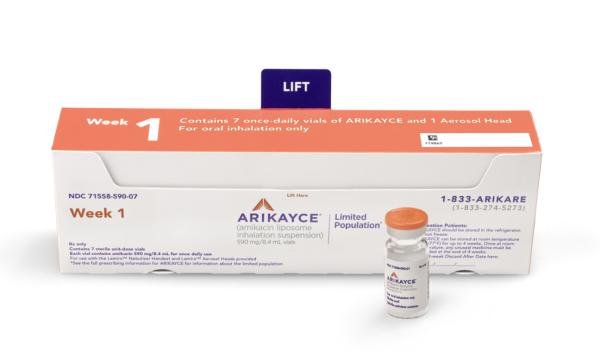Arikayce Side Effects
Generic name: amikacin liposome
Medically reviewed by Drugs.com. Last updated on Oct 7, 2023.
Note: This document contains side effect information about amikacin liposome. Some dosage forms listed on this page may not apply to the brand name Arikayce.
Applies to amikacin liposome: inhalation suspension.
Warning
Inhalation route (Suspension)
Amikacin liposome has been associated with an increased risk of respiratory adverse reactions, including, hypersensitivity pneumonitis, hemoptysis, bronchospasm, and exacerbation of underlying pulmonary disease that have led to hospitalizations in some cases.
Serious side effects of Arikayce
Along with its needed effects, amikacin liposome (the active ingredient contained in Arikayce) may cause some unwanted effects. Although not all of these side effects may occur, if they do occur they may need medical attention.
Check with your doctor immediately if any of the following side effects occur while taking amikacin liposome:
More common
- Chest tightness
- cough
- coughing or spitting up blood
- difficulty breathing
- dizziness
- feeling of fullness in the ears
- fever
- loss of balance
- loss of hearing
- noisy breathing
- ringing or buzzing in the ears
- sore throat
- trouble hearing
- upper airway irritation
- voice changes
Less common
- Balance disorder
- blue lips, fingernails, or skin
- change in sputum
- chest discomfort or pain
- chills
- cough producing mucus
- general feeling of discomfort or illness
- irregular, fast or slow, or shallow breathing
- nosebleed
- severe pain in the chest
- sudden onset of severe breathing difficulty
- thickening of bronchial secretions
Incidence not known
- Difficulty swallowing
- hives, itching, skin rash
- puffiness or swelling of the eyelids or around the eyes, face, lips, or tongue
- unusual tiredness or weakness
Other side effects of Arikayce
Some side effects of amikacin liposome may occur that usually do not need medical attention. These side effects may go away during treatment as your body adjusts to the medicine. Also, your health care professional may be able to tell you about ways to prevent or reduce some of these side effects.
Check with your health care professional if any of the following side effects continue or are bothersome or if you have any questions about them:
More common
- Bone or muscle pain
- decreased weight
- diarrhea
- headache
- lack or loss of strength
- nausea
- rash
- vomiting
Less common
- Anxiety
- change in taste
- dry mouth
- loss of taste
For Healthcare Professionals
Applies to amikacin liposome: inhalation suspension.
General
The most commonly reported side effects included dysphonia, cough, bronchospasm, and hemoptysis.[Ref]
Respiratory
Very common (10% or more): Dysphonia (up to 47%), cough (up to 39%), bronchospasm (up to 29%), hemoptysis (up to 18%), upper airway irritation (up to 17%), exacerbation of underlying pulmonary disease (up to 15%)
Common (1% to 10%): Bronchitis, change in sputum, epistaxis, hypersensitivity pneumonitis, pneumonia, pneumothorax, respiratory failure
Frequency not reported: Acute respiratory failure, allergic alveolitis, aspiration pneumonia, asthma, atypical pneumonia, bronchial hyperreactivity, chronic obstructive pulmonary disease (COPD) exacerbation, dyspnea, dyspnea exertional, increased sputum, infective exacerbation of bronchiectasis, infective exacerbation of COPD, interstitial lung disease, laryngeal erythema, laryngeal pain, laryngitis, lower respiratory tract infection, lung infection, lung infection pseudomonas, oropharyngeal discomfort, oropharyngeal pain, pharyngeal edema, pharyngeal erythema, pleural effusion infection, productive cough, pneumomediastinum, pneumonia pseudomonas, pneumonitis, prolonged expiration, respiratory tract infection, spontaneous pneumothorax, sputum discolored, throat irritation, throat tightness, upper airway cough syndrome, upper airway inflammation, vocal cord inflammation, wheezing[Ref]
Other
Very common (10% or more): Ototoxicity (up to 17%), asthenia (up to 16%), fatigue (up to 16%)
Common (1% to 10%): Chest discomfort, exercise tolerance decreased, pyrexia
Frequency not reported: Body ache, deafness, exacerbation of underlying disease, hypoacusis, neurosensory deafness, pain, tinnitus, unilateral deafness[Ref]
Gastrointestinal
Very common (10% or more): Diarrhea (up to 13%), nausea (up to 12%)
Common (1% to 10%): Dry mouth, oral fungal infection, vomiting
Frequency not reported: Oral candidiasis, post-tussive vomiting[Ref]
Musculoskeletal
Very common (10% or more): Musculoskeletal pain (up to 17%)
Frequency not reported: Arthralgia, back pain, muscle spasm, muscle weakness, myalgia[Ref]
Nervous system
Common (1% to 10%): Balance disorder, dysgeusia, headache, neuromuscular disorder
Frequency not reported: Aphonia, dizziness, neuromuscular blockade, peripheral neuropathy, presyncope, vertigo[Ref]
Dermatologic
Common (1% to 10%): Rash
Frequency not reported: Drug eruption, maculopapular rash, urticaria[Ref]
Psychiatric
Common (1% to 10%): Anxiety[Ref]
Metabolic
Common (1% to 10%): Decreased weight[Ref]
Immunologic
Frequency not reported: Empyema, pseudomonas infection, sputum purulent[Ref]
Renal
Frequency not reported: Nephrotoxicity[Ref]
Frequently asked questions
More about Arikayce (amikacin liposome)
- Check interactions
- Compare alternatives
- Pricing & coupons
- Drug images
- Dosage information
- During pregnancy
- FDA approval history
- Drug class: aminoglycosides
- En español
Patient resources
Professional resources
Related treatment guides
References
1. Product Information. Arikayce (amikacin liposome). Insmed Incorporated. 2018.
Further information
Always consult your healthcare provider to ensure the information displayed on this page applies to your personal circumstances.
Some side effects may not be reported. You may report them to the FDA.

